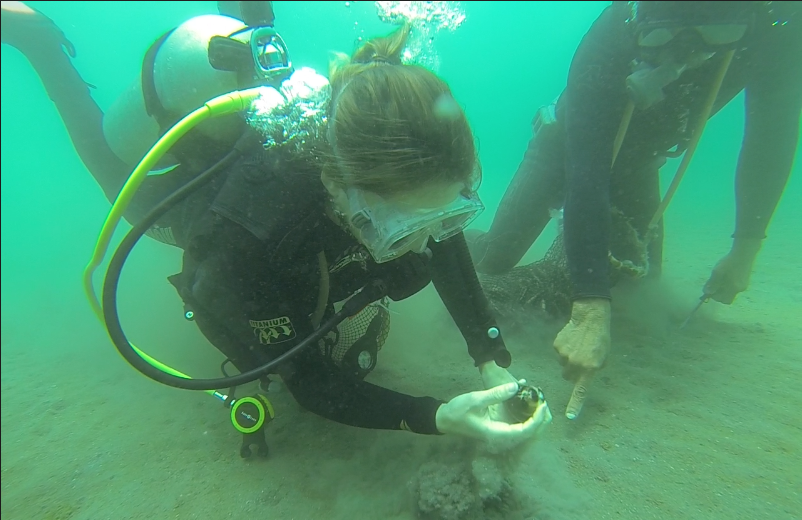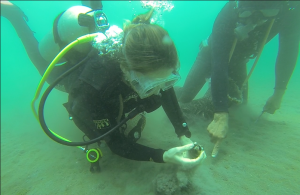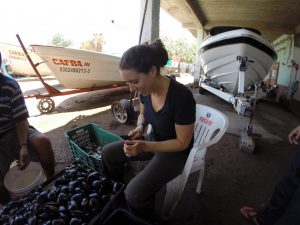
Sustaining Mexico’s chocolate clam fishery

Field notes by Kara Pellowe, University of Maine graduate student
I have been studying the chocolate clam fishery in Loreto Bay National Park since 2013, as part of my dissertation research in University of Maine’s Graduate Program in Ecology and Environmental Sciences (EES). As a marine conservation scientist, I also work closely with faculty in UMaine’s School of Marine Sciences, and am based at the Darling Marine Center, in Maine’s midcoast region.
My interdisciplinary research looks at how ecological and social factors interact to affect the sustainability of the clam fishery. The communities where I work, including Loreto, are tucked into a strip of Baja desert between the calm, glittering blue waters of the Sea of Cortes, and the jagged peaks of the Sierra de la Giganta mountain range. Tourism and commercial fishing drive Loreto’s economy, and one of the top fished species in Loreto is the Mexican chocolate clam, Megapitaria squalida.
Chocolate clams are found from the Baja peninsula south along the Pacific coast to Peru, but they have particular importance in Loreto, where they not only contribute to the local economy, but also enjoy a rich cultural and culinary tradition. Chocolate clams also provide an important source of supplementary food and income for many families in the region. Chocolate clams are found buried in sandy-muddy sediment on the ocean floor, at depths of 1-120 m. They are harvested via free-diving, where the diver holds their breath and dives to the ocean floor, and via hookah diving, where a gasoline-powered compressor pumps air from a boat down to a diver on the ocean floor.

During my recent fieldwork in Loreto, I investigate the importance of chocolate clams to Loreto households, in terms of food, employment, and cultural and recreational values. I surveyed local residents and used other established anthropological methods, e.g., interviews and participant observation, to document the connections between the clam fishery, local marine ecosystem and people of Loreto. The trip also gave me an opportunity to share results of my last five years of work with the local community. I gave two public talks in both English and Spanish, which were well attended by a mix of scientists, tourists, fishermen and other community members.
My dissertation draws on both natural and social science approaches to advance understanding of how this fishery can be sustained into the future. With this ‘sustainability science’ approach, I undertook a series of complementary studies on both clam biology and fishing activities. These included studies of clam growth, clam abundance and sizes in Loreto Bay National Park, the sizes of clams harvested by fishermen, and the effect of different minimum and maximum legal sizes on clam populations. I also studied the fishery, including the various types of people involved in the chocolate clam fishery, and current processes for creating chocolate clam management. I have found that conservation of the species is hindered by the loss of traditional fishing rights. This loss of rights has excluded a diversity of voices from management conversations, reduced community confidence in fisheries management, and made chocolate clam management a divisive local issue. My research has shown that fishers’ ecological knowledge, together with the broader community’s desire to conserve and protect these clams for future generations, could be crucial components of sustaining this fishery and the ecosystem of which it’s a part.
Based on my studies, I developed the following recommendations to improve the sustainability of the chocolate clam fishery and the values it provides to the local community:
1) Cultivate meaningful involvement in management by diverse members of the community;
2) Consider establishing a maximum legal size, in addition to the current minimum legal size to maximize the reproductive potential of chocolate clam populations; and
3) Protect and legalize the equitable distribution of traditional fishing rights.
I have shared these recommendations with local residents and fisheries managers, and look forward to continuing to work in the Loreto area in the future. My graduate education at UMaine has led me to new questions and ways of thinking about how marine species and ecosystems are interwoven into the lives of people in coastal communities. I have discovered that communities near and far often face similar challenges, and that lessons learned in one context can contribute to better understanding in another. My education at UMaine has taught me the importance of forging connections between scientists and coastal communities, and has prepared me for a future in applied marine conservation.
Kara’s research is supported by the US National Science Foundation (DEB-1632648, a project led by her advisor, Heather Leslie). Kara and Heather are part of an interdisciplinary team focused on the environmental and human dimensions of Baja’s small scale fisheries, MAREA, and also participate in engaged research related to Maine fisheries and fishing communities. Learn more at https://umaine.edu/leslie-lab/ .
